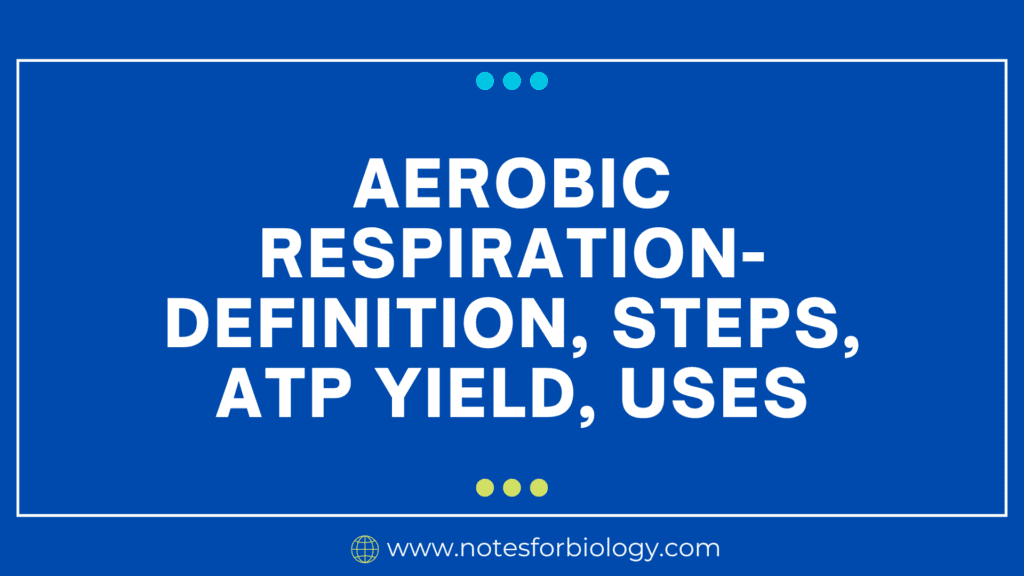Aerobic Respiration is the metabolic process by which cells convert glucose and oxygen into energy, CO2, and water. This process occurs in the mitochondria of eukaryotic cells and is required for the generation of ATP (adenosine triphosphate), which cells utilize as energy. The general process of this can be expressed as:
C6H12O6 (Glucose) + O2 (Oxygen) → 6CO2 (Carbon dioxide) + 6H2O (water) + ATP (Energy)
Table of Contents
Definition of Aerobic Respiration
Aerobic Respiration is the process by which organisms utilize oxygen to convert fuels (such as fats and carbohydrates) into chemical energy. It is found in most eukaryotic cells, including those from plants, animals, and humans. It is found in most eukaryotic cells, including those from plants, animals, and humans. It generates adenosine triphosphate (ATP), the fundamental energy currency within cells. It is also said as A metabolic route that employs oxygen to thoroughly oxidize glucose (or other organic compounds), producing energy, CO2, and water. It consists of a sequence of metabolic events, including glycolysis, the citric acid cycle (Krebs cycle), and oxidative phosphorylation via the electron transport chain.
Steps under Aerobic Respiration
Glycolysis
It occurs in the cytoplasm and breaks down glucose into two molecules of pyruvate. Glycolysis also generates a net gain of 2 ATP and 2 NADH.
Pyruvate Oxidation
It occurs within the mitochondrial matrix and converts pyruvate to acetyl-CoA. Pyruvate Oxidation produces NADH and emits CO2.
The Krebs Cycle (Citric Acid Cycle)
It occurs inside the mitochondrial matrix and converts acetyl-CoA into NADH, FADH2, and ATP. Also, releases carbon dioxide as a byproduct.
Electron transport chain (ETC) and oxidative phosphorylation
This occurs in the inner mitochondrial membrane and creates a proton gradient by using electrons from NADH and FADH2. It drives ATP production via chemiosmosis. Oxygen serves as the last electron acceptor, producing water.
ATP Yield under Aerobic Respiration
Adenosine triphosphate (ATP) is a chemical that transports energy across cells12. Photophosphorylation, cellular respiration, and fermentation all create it, which is the cell’s primary energy source. It is an essential chemical in the energy management of cells. Its ability to store and release energy makes it essential to life, powering the numerous processes required for cell survival, development, and function. The continual cycle of ATP generation and hydrolysis guarantees that cells have enough amount of energy to satisfy their needs. ATP Yield in a eukaryotic cell, cellular respiration may convert one molecule of glucose into 30 to 32 ATP. Glycolysis creates just two ATP, whereas the rest are created throughout the electron transport chain.
Uses for Aerobic Respiration
- Green plants need the CO2 generated throughout the process to perform photosynthesis.
- Numerous intermediate molecules, coenzymes, and organic acids are generated.
- They are utilized to synthesize proteins from amino acids during anabolic processes.
- They are utilized in the aerobic composting and biodegradation process.
- Its primary function is to produce energy in the form of ATP in aerobic organisms’ cells.
Frequently asked questions
What is Aerobic Respiration?
It is a biological process in which organisms use oxygen to convert nutrients, such as fats and sugars, into chemical energy. This energy is stored in molecules called adenosine triphosphate (ATP), which are used to power various cellular activities.
Why is oxygen important in aerobic respiration?
Oxygen is the final electron acceptor in the electron transport chain. It combines with electrons and protons to form water, which is crucial for maintaining the flow of electrons through the ETC and for the generation of ATP.
What are the end products of aerobic respiration?
The end products of aerobic respiration are ATP (energy), carbon dioxide (CO2), and water (H2O).
Where does aerobic respiration occur in the cell?
Aerobic respiration occurs in the mitochondria of eukaryotic cells. Glycolysis takes place in the cytoplasm, while pyruvate oxidation, the citric acid cycle, and the electron transport chain occur within the mitochondria.
Related Articles

